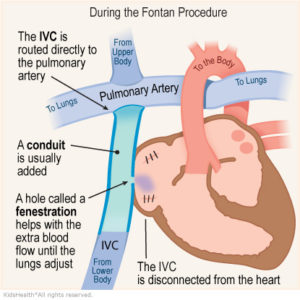The Fontan procedure is most often performed on single ventricle heart defects. It is the third step in the three step Fontan series. It is normally done between the age of 18 months to three years. The goal of the Fontan procedure is to reroute the blood from the lower body passively to the lungs. 1

Surgeons performing the Fontan procedure have the main goal of making blood from the lower part of the body go directly to the lungs. This allows blood to become oxygenated without having to pass through the heart. This reduces the heart’s workload. 2
To redirect the blood from the lower body, two major steps are performed. The inferior vena cava is disconnected from the heart and attached to the pulmonary artery through a conduit. Then, usually a fenestration (small hole) is made between the new conduit and the right atrium. This allows for some blood to still flow back to the heart. It also acts as a “pop off” valve for the lungs to reduce pressures due to extra blood flow from the lower part of the body. The fenestration can later be closed during a heart cath. After the Fontan, oxygen rich and oxygen poor blood are separated, meaning more oxygen can get to the body. 2 Other steps may take place to ensure proper blood flow as each patient’s anatomy is unique.
These steps act as hold over measure until the next needed medical intervention. This is not a cure for CHD and does not make the heart fully function as it should. To learn about normal heart anatomy, read our blog How My Heart Works.
In 1968, Francis Fontan first performed his original concept of the Fontan procedure on a patient with Tricuspid Atresia. Since then it has become the final step in the treatment of HLHS and single ventricle heart defects. 3
The Fontan procedure was and is an amazing advancement in the field of cardiology. It has improved life expectancy and quality of life tremendously but should not be mistaken for a permanent solution as there is currently no cure. However, Project Heart is on a mission to find a cure for CHD.
Hi, my son is 5 he has hlhs, vsd, add, av canal, tricuspid atresia, co-arch, and re-co-archtation, we had one surgeon for the Glenn and norwood, then he moved and we received a new surgeon for the 3rd procedure, the re co archtation, my son had his pre fontan Cath on Sept 16th, we were set to have surgery a couple weeks later but the day before he tested positive for rhinovirus, so surgery was cancelled now my sons cardio team called to inform us the surgeon is now denying my son fontan saying he is too high risk, after a month is retesting and hold on flu shot and no school, we are currently waiting on a surgeon from 3 different hospitals in Texas that might take on his case but they have to do their own evaluation before we know if he’s going to get his surgery. Right now we’re at a loss and trying to find the best solution to help our son…